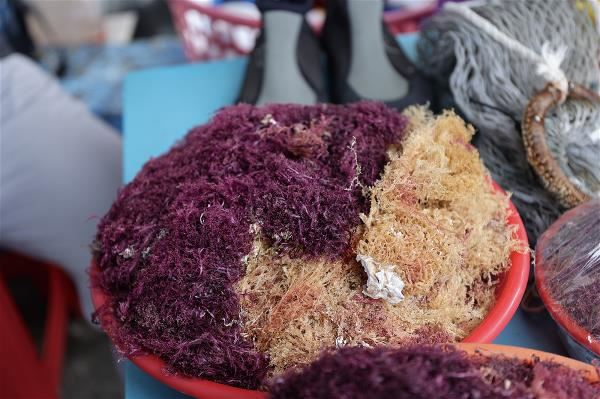2025-8-29
Chen Chun-fang /photo by Jimmy Lin /tr. by Brandon Yen
(Courtesy of Taiwan Panorama August 2025)
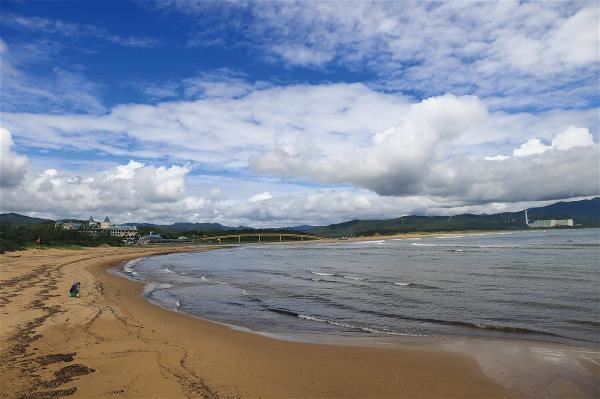
“The only true voyage, the only fountain of Youth, would not be to visit strange lands, but to possess other eyes, to see the universe with the eyes of another....” —Marcel Proust
Known as Sandiaowan (Sandiao Bay), the rugged coastline between Cape Bitou and Cape Santiago in Northeastern Taiwan features distinctive rocky headlands. Rich in cultural heritage, the area has been home to Plains Indigenous people and Han settlers, and was where the Spanish fleet landed during the Dutch and Spanish colonial era (1624–1662). It was also here that the Japanese colonists first landed in the wake of the Treaty of Shimonoseki (1895). This place feels like a secluded paradise, bearing the stamp of history and offering glimpses of the locals’ fascinating ways of life.
“Taiwan boasts the greatest environmental diversity within the smallest area and the shortest distances,” says Kuo Chen-meng, honorary chair of the Taiwan Ecotourism Association. Collaborating with fellow members of the association, he has unveiled the beautiful story of Sandiaowan by examining the living landscape and its connections with the daily lives of locals.
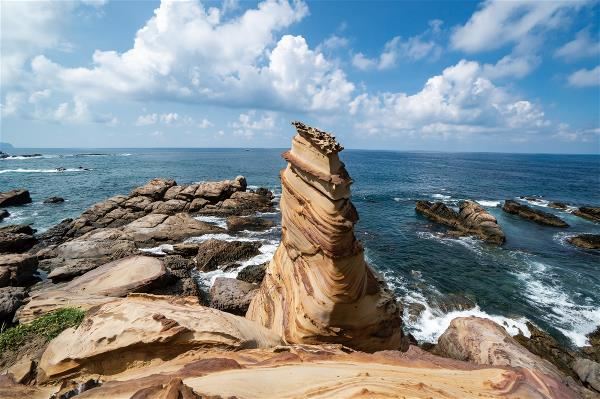
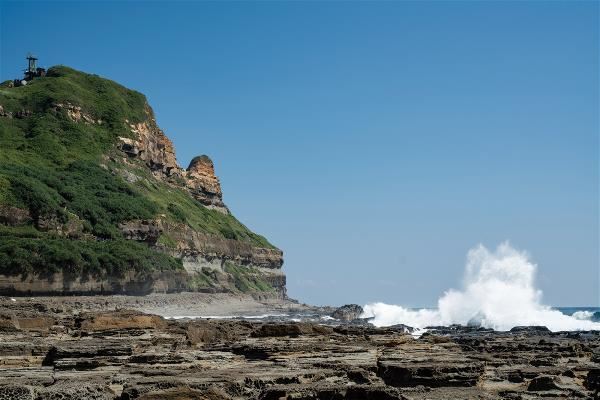
Nature’s wonders
Across Taiwan, only the Northeast Coast features a succession of alternating headlands and bays. Here, mountain ridges run almost at right angles to the coastline. Bands of hard rock, which is more resistant to coastal erosion, form headlands jutting into the sea, while areas made up of softer materials have been eroded into bays. The waves and the northeasterly monsoon winds conspire to sculpt the coast into a conglomeration of fantastic shapes, such as the mushroom and honeycomb rocks at Cape Bitou, and rocks resembling a turtle and a poodle at Aodi. The Northeast Coast is dotted with nature’s wonders.
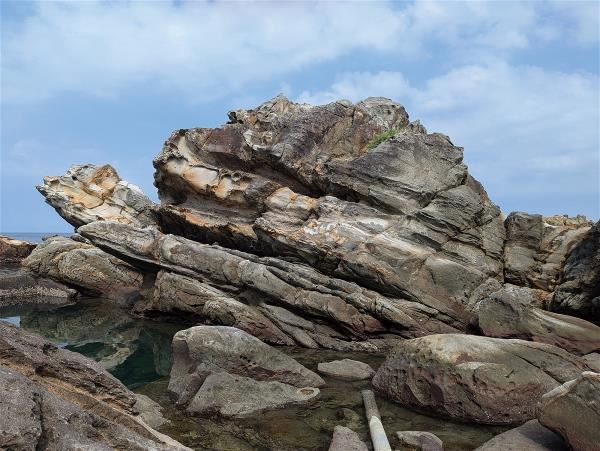
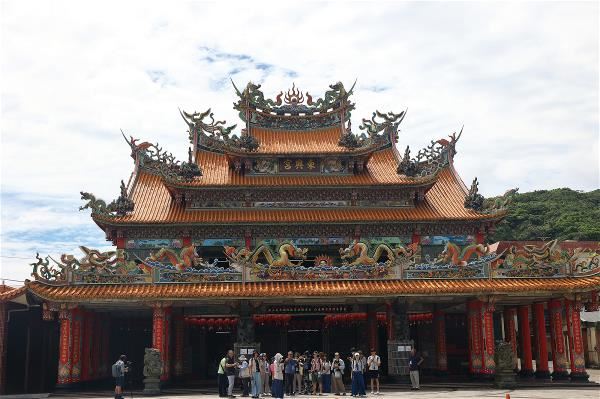
Reading the landscape
Standing in front of Dongxing Temple at Fulong in New Taipei’s Gongliao District, we gain a panoramic view of the estuary of the Shuang River, Longmen Beach, and Longmen Suspension Bridge, with Cape Bitou and the mountains of the Western Foothills in the distance. Kuo explains that Fulong Beach owes its golden sand to sediments from these mountains. Rain carries sand down the Shuang River to the estuary, while the northeasterly monsoon winds exert a resistive force, so that the fine particles don’t all disappear into the sea. The coastal currents here also serve to transport and deposit sand along the seaboard. Thanks to the combined forces of river and sea, this sand was gradually formed into a sandspit, with one end attached to the land and the other stretching out into the ocean.
Not only natural forces but also different ethnicities have converged along the shoreline of Gongliao District. Legend has it that some one or two millennia ago, the Basay—one of Taiwan’s Plains Indigenous peoples—arrived from an island named Sanasai. Having landed on Longmen Beach, some of them traveled north, where their descendants became the Ketagalan. Others moved south to Yilan and eventually became the Kavalan. Those who remained near Cape Santiago established a settlement at the mouth of the Shuang River.
Some 300 years ago, the area around Longmen and Aodi—which was particularly suitable for waterborne transport—began to attract Han settlers. Wu Sha (1731–1799), a pioneering settler from Fujian, used Aodi as a base from which he extended his activities into the Yilan Plain. His tomb in Aodi bears witness to the historical importance of the place. It was also in Aodi that the Imperial Guards Division of the Japanese army landed in 1895. A monument was built at what is now Yanliao Beach Park to commemorate the event (it was destroyed after World War II, with the Yanliao Anti-Japanese Monument erected on the same site in 1975). The coastal landscape testifies to the confluence of various ethnic groups in the past 2,000 years, a process that gradually created the Taiwan we know today.
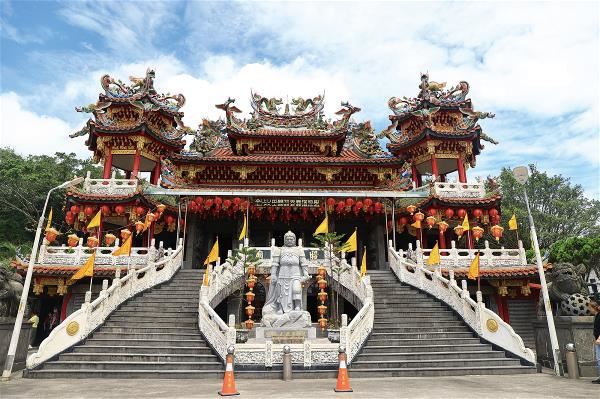
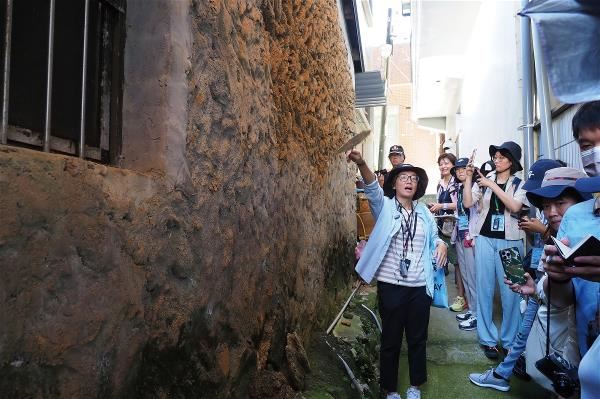
Longmen Village
Longmen Village in Gongliao District sheds further light on the historical textures of the Northeast Coast.
“Have you heard of Longmen?” Wu Hanen, founder of Dawn Culture Studio, likes to kickstart her guided tours by asking this question. Some think of the 1967 wuxia film Dragon Inn (a.k.a. Dragon Gate Inn, longmen being the Chinese for “dragon gate”); others are reminded of the famous dumpling house of the same name. Few expect to find such astonishingly rich geography and culture in this far-flung area of Northeastern Taiwan.
With the opening of the coastal highway, most vehicles traveling through this region now bypass Longmen. Few take the time to visit the village. Wu tells us that Longmen, cradled by the Pacific Ocean and the Shuang River, used to bustle with river traffic. Abutting the mouth of the river, it served as a transport hub, with connections to Keelung and Tamsui to the west, and the Tamsui–Kavalan Trails and Yilan to the south. It was the third-biggest settlement in Gongliao.
Walking into the village, we sense how Longmen came to be shaped by its intimate ties with the river and the sea. In the old days, locals relied on fishing for their livelihoods: they seined on the beach, and in winter caught elvers at the river mouth. Seiner’s rice—a local specialty—is a meal parcel traditionally prepared for seiners. Mushrooms, pork mince, and cracklings are stir-fried together and then simmered with raw rice. When cooked, the mixture is wrapped in macaranga and sea hibiscus leaves and tied with rush grass from the estuary. It brims with local flavors.
In the vicinity of the century-old village well is a beautifully intact stone-built sanheyuan (a residence with a courtyard enclosed by buildings on three sides): the Wu Family House. Wu tells us that the foundation stones here, which are two to three meters long, were originally used as ships’ ballast, recalling the days when eminent local families derived their economic power from waterborne trade. The architecture preserves stories of Longmen’s emergence and development. Wandering through the streets, we also notice a special kind of house built of sandstone quarried from the Shuang River. Wind-resistant and rainproof, it embodies distinctive local characteristics.
As well as being blessed with a rich diversity of coastal flora, this tranquil village is layered with historical memories: traditional fisheries, Chinese settlement, the rise and fall of river transport, and interactions between Chinese settlers and indigenous locals.
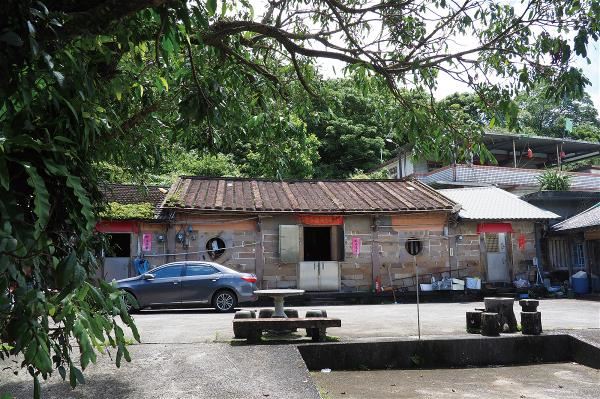
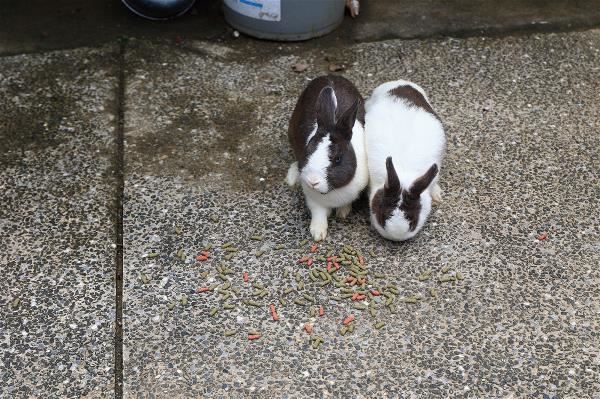
Gongliao Old Street
Kuo Chen-meng observes that something Taiwan excels in is promoting tourism through everyday experiences rooted in local life. While Longmen is a historic settlement nestling by the river and the sea, Gongliao Old Street, which lies further inland, is tucked in the midst of mountains and streams, radiating a warm, welcoming vibe. Though barely 200 meters long, the street holds an abundance of local memories. Here, at Lewen Clinic, Dr. Chang Yin-chao has devoted many years to caring for Gongliao residents, not only providing transportation to and from the clinic for his patients but also making house calls in remote mountainous areas.
The street is also home to a variety of businesses, including a café managed by retirees, an old barbershop, and a shop selling glutinous-rice buns flavored with Chinese mugwort, as well as stalls run by local women in front of their houses, offering seasonal vegetables and native yams. They insist on selling only good-quality produce from trustworthy local sources.
Gongliao Old Street used to buzz with life and energy, with as many as eight or nine butchers plying their trade here. Catering to all daily needs, the place was a vital trading post where seaside and inland communities came together. No longer a prosperous commercial hub today, it nevertheless exudes a different charm with its unassuming beauty. Residents continue to gather at Fangjiao Creek to do their laundry and catch up with each other. Situated near one end of the street, Mong-ho-ho Barn brings together local agricultural produce and handmade goods. To pay tribute to local farmers, it decorates one of its walls with panels of rice straw arranged horizontally, evoking the look of wind-battered rice plants in a typhoon.
“People here are like non-player characters in a video game. It’s only when you actively strike up a conversation with them that you realize that they have loads of stories to tell,” Yuan I-chieh, owner of U Pudding Coffee, says with a smile. For her, Gongliao Old Street, though no longer a bustling commercial center, is a place where one is free to be oneself.
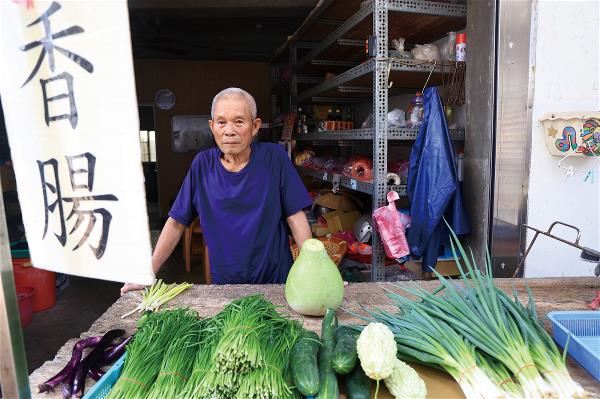
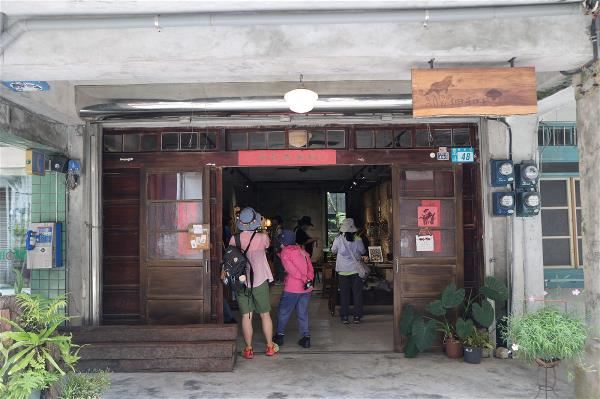
Diving deep
Life in this northeastern corner of Taiwan unfolds not only on land but also amidst the waves. In Aodi, we meet Chen Yue-yun, a diver with more than six decades of undersea experience.
“I started diving when I was ten,” says the 74-year-old, by which she means diving into the sea to gather seaweed, sea urchins, and other marine treasures. Another common activity was foraging in the intertidal zone or among coastal rocks. Chen tells us that life here was tough: mountain folk had to live off the land, while those living near the coast had to make the most of the sea.
In Northeastern Taiwan, gelidium seaweeds are usually harvested between April and June. At low tide, women dive into the sea to collect it. The seaweed is then washed and dried seven times to remove grit and other impurities. The color of the algae gradually turns from dark red to pale yellow. Only then can it be used to make sea-flavored jelly. Chen doesn’t rely on any modern gear, nor does she wear a wetsuit. She simply ties a kerchief round her head, dons a pair of homemade wooden goggles, straps a net basket to her waist, and away she goes.
This job is attended with risks: divers need to use their hard-won experience to assess the sea’s ever-changing moods. Chen could have retired long ago, but diving has become such an integral part of her body memory that she feels the sea beckoning to her when the gelidium harvesting season arrives. She continues to dive and to make soft, chewy seaweed jelly, safeguarding this authentic flavor of the Northeast Coast.
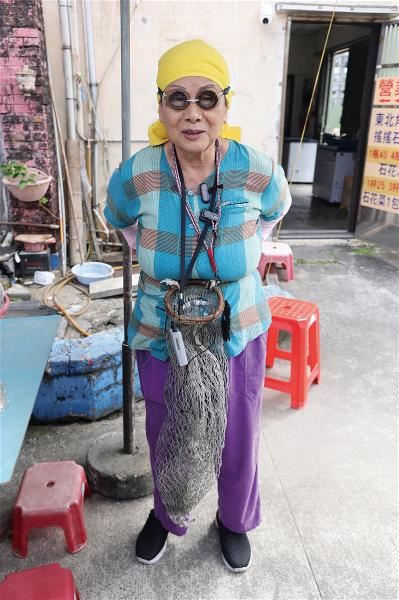
Flavors of the sea
Going north along the seaboard, we see an aquafarm—Nice Store—glittering in the sun. The convergence of ocean currents here, plus stable levels of salinity and the rocky environment of the intertidal zone, makes this an ideal habitat for abalone. It is said that 80% of farmed abalone produced in Taiwan comes from Sandiaowan. Li Shengxing, owner of Nice Store, returned to his native village more than ten years ago to take over his father’s aquaculture business. From focusing exclusively on abalone in the early days, he has diversified into white shrimps, sea grapes, and purple sea urchins, giving the once-abandoned aquafarm a new lease of life.
Visitors to Nice Store can buy fresh sea products, learn about aquaculture by attending a guided tour, try searing abalone, or feed algae to live abalone through a hose. Li, a veteran connoisseur of abalone cuisine, tells us that “searing is the best way to bring out the delicious flavor of abalone—the taste takes us down memory lane.” Abalone are harvested from autumn till spring. In Li’s memory, when the northeasterly monsoon winds blew during the wintry months, adults would be busy collecting abalone, while children would huddle around fires to keep warm and to roast the mollusks in secret. They’d get told off when found out, but the delectable taste was unforgettable.
With a view to bringing the flavors of his local sea into everyday life, Li has developed products such as sea-grape noodles and seafood pizzas. He believes that “local revitalization needs to involve characteristic local industries, so that talented natives want to return and stay.” Li’s shimmering aquafarm puts his ideals into practice, slowly but surely nurturing the authentic flavors of Northeastern Taiwan.
Sandiaowan and its vicinity promise a remarkable mixture of special landforms, cultural heritage, history, fishing traditions, coastal flora, and craftsmanship. Slow down and explore your sensory perceptions: the coastal villages here will respond to you in surprising ways.
